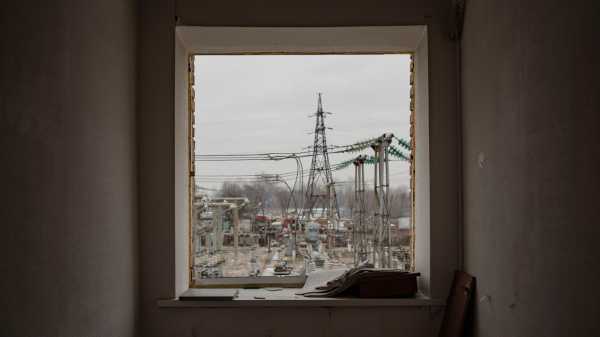
One day last fall, a Kh-101 cruise missile, launched from a Russian strategic-bomber plane, slammed into an electrical substation on the outskirts of Kharkiv, a Ukrainian city of more than a million people twenty-five miles from the Russian border. The strike blew apart the station’s control room, sending bricks and steel flying. The roof collapsed; equipment was incinerated in a wall of fire. Two workers for Ukrenergo, the state electricity company, were on duty in the control room and were killed instantly. Kharkiv was plunged into darkness. “They know where they are aiming,” a repairman named Vadim said. (Like a number of power-grid employees I spoke with, he asked not to use his full name.) “They hit the most critical places.”

Serhii, an electrician at a substation in the Kharkiv region.
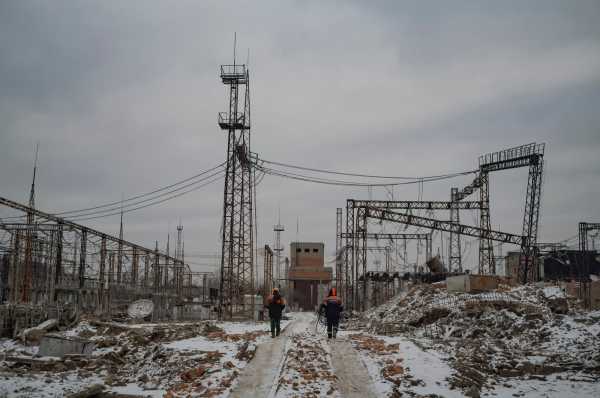
Ukrenergo workers at a substation in eastern Ukraine are salvaging pieces of equipment that still can be used for repairs.
Since the beginning of Russia’s invasion, its attacks had periodically damaged energy infrastructure near the front lines. “That we were used to,” Dmytro Sakharuk, the executive director of DTEK, Ukraine’s largest private energy company, said. “But then they changed strategy.” Starting last fall, the Russian military began targeting coal-fuelled power plants, substations, and transformers across the whole of Ukraine. Russian officials wagered that by depriving Ukrainians of electricity—and, as a result, heat and water—during wintertime, they would sap the country’s resolve. “They wanted to initiate a long-term blackout and to freeze our big cities,” Volodymyr Kudrytskyi, the C.E.O. of Ukrenergo, told me. “The idea was to force us to negotiate not through emerging victorious on the battlefield but by terrorizing the population.”

Dmytro Sakharuk, the executive director of DTEK, photographed at a former underground parking area that has been repurposed as a shelter where corporate workers descend every time there is an air-raid alarm.
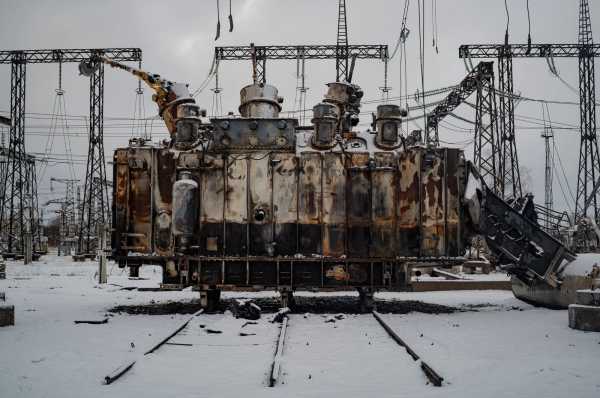
A damaged high-voltage transformer at a substation in western Ukraine.
After successive waves of Russian strikes, Ukraine has faced a stark electricity deficit and rolling blackouts. At any given moment, millions of Ukrainian households are without power, as part of a centrally managed schedule that splits each day into three color-coded periods: green (guaranteed electricity), orange (no electricity), and white (cuts are possible). The guttural purr of diesel generators has become the background noise to life in just about every major Ukrainian city, as shops and restaurants have struggled to keep their lights on.
“We want to at least make these cuts predictable,” Kudrytskyi said. “It’s not just about making sure people survive the winter but also making sure they can work, and that businesses can operate, so that there is a domestic economy that, in turn, can fund the army.”
Not long ago, Ukraine and Russia, along with Belarus, shared the same electricity grid, an arrangement that independent Ukraine inherited from the Soviet period. Last year, on the eve of the war, Ukraine finalized a long-awaited plan to disconnect from the Russian grid and reorient its electrical network toward Europe. But the physical legacy of its shared past with Russia remains: much of the crucial equipment in the energy sector, from power-generating turbines to transformers and control-panel switches, are of Soviet vintage. The layouts of Ukraine’s plants and substations hardly vary from those in Russia; all were constructed from blueprints still readily available in Moscow.
“Our station was built from a Mosenergo project that dates to the nineteen-sixties,” Roman, the head of a substation in the Lviv region, said, referring to the Russian state power company that serves Moscow. “I imagine them sitting holding these plans in their hands, pointing out exactly what should be hit.”

The main switchboard at a power plant in western Ukraine.

Maksym, the chief engineer at a power plant in western Ukraine where one of the power units was hit by a direct strike, completely destroying it.

Dmytro, Roman, and Halyna are main-switch operators at one of the power plants in western Ukraine.
The Russian campaign has a certain logic. Initial strikes focussed largely on transformers and substations—the pumps and arteries of an electrical grid, which convert electricity from one voltage to another and move it across the system, eventually delivering it to a person’s home. That equipment tends to be exposed, placed in the open, whereas the vast turbine halls of power plants, sheathed by a casing of concrete and steel, present a harder target.
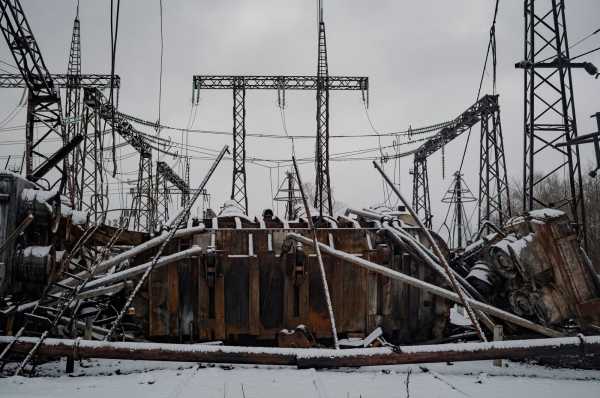
A damaged high-voltage transformer at a substation in western Ukraine.
A substation in central Ukraine hosts a number of seven-hundred-and-fifty-kilowatt transformers, each one the size of a moving van and capable of transporting large quantities of electricity over long distances. Not only are these transformers crucial for Ukraine’s energy grid—they are the only model of transformer capable of accepting high-voltage electricity produced by a nuclear power plant, for example—but they are also relatively rare. Similar models are found in the United States and China, but nowhere else in Europe; ordering and producing a new one can take up to a year. Ukraine has one factory that makes seven-hundred-and-fifty-kilowatt transformers, but it is situated in Zaporizhzhia, a city in the south that has come under regular bombardment.
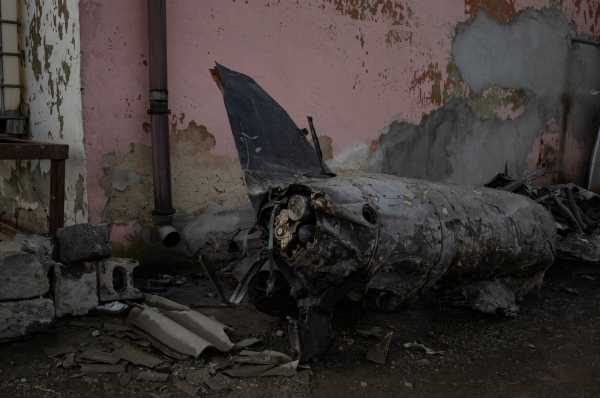
The remains of a Russian long-range missile at a power plant in western Ukraine.
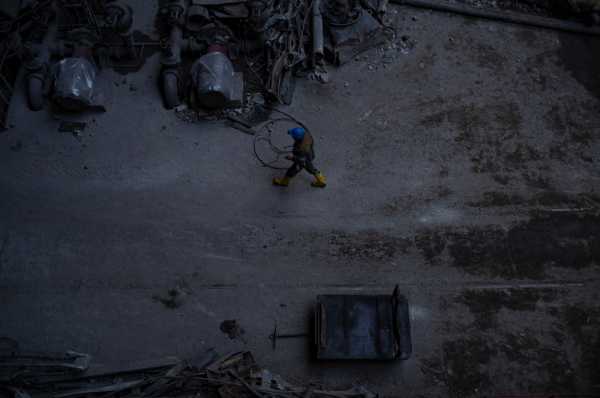
A DTEK worker walks in the aftermath of a Russian strike on a power plant in western Ukraine.
The first strikes at the substation damaged a number of transformers. Repair crews managed to receive spare parts from across Ukraine, and spent weeks trying to bring whatever they could back online. The hope was that the station could function with limited capacity. But then, on New Year’s Eve, the station was hit again, this time by an Iranian-made kamikaze drone. The repaired transformers were destroyed completely.
“That’s when, you might say, we ran out of hardware and patience all at once,” Taras, the head of the facility, told me. “At the current moment, the station doesn’t carry out its function whatsoever.” Workers found one of the drone’s wings in the snow. “Happy New Year” was written on the underside, in Russian. “They must have been proud, and thought this was funny,” Taras said.

Sandbag barriers were erected to protect the equipment at a power plant in western Ukraine.
Later waves of Russian strikes targeted power generation itself. At one power plant in western Ukraine, a missile hit the turbine hall, destroying one power unit and damaging others. One of the units is still smoldering, weeks after it was hit, letting out a hiss of dark smoke. According to Maksym, the facility’s chief engineer, the plant is functioning at only a third of its previous capacity. Even that output makes it a target.
“You go to work every day with a certain fear,” Makysm said. Although most personnel head to the bomb shelter during air-raid alerts, Maksym remains at his post in the central control room. He pointed to a rack of helmets and flak jackets. “We tell our guys we are also at war,” he said. “This is our front—to keep the electricity flowing.”
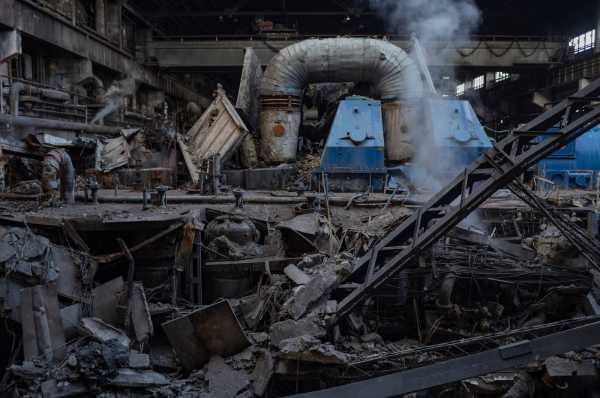
A destroyed power unit at one of the plants in western Ukraine.
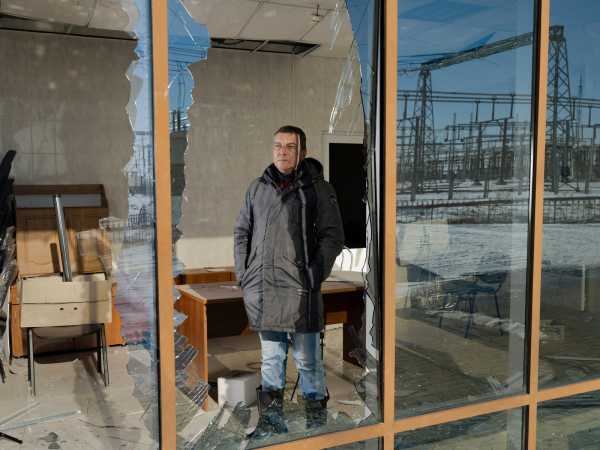
Taras, head of a substation in the Kyiv region that houses seven-hundred-and-fifty-kilowatt transformers, stands in the facility’s damaged office building.
Russia’s strategy of plunging the country into darkness and cold has, if not outright failed, certainly not succeeded, either. Public opinion has not shifted as a result of the blackouts—polls in recent months have shown that more than eighty per cent of respondents in Ukraine want to continue the fight, the same number as before the attacks on the energy grid began. Over time, Ukraine’s air defenses have improved, and its technicians have got faster at repairing the electrical grid. Russia’s stock of long-range missiles, meanwhile, has dwindled, leading to less frequent attacks.
The onset of spring will bring lower electricity consumption, and Kudrytskyi, the head of Ukrenergo, expects that the Ukrainian grid will soon stabilize. “Russia did not achieve its ultimate goal,” he said. “Yes, they managed to create problems for nearly every Ukrainian family.” But that is only half the story: “Instead of making us scared and unhappy, it made us angry, more resolved to win. They did not lower the morale of the nation; they mobilized the nation.”
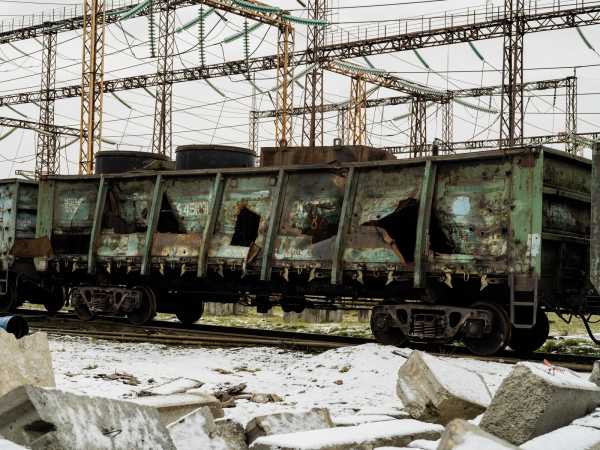
Damaged freight cars at a power plant in western Ukraine.
Sourse: newyorker.com






